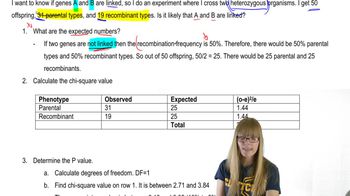Table of contents
- 1. Introduction to Genetics51m
- 2. Mendel's Laws of Inheritance3h 37m
- 3. Extensions to Mendelian Inheritance2h 41m
- 4. Genetic Mapping and Linkage2h 28m
- 5. Genetics of Bacteria and Viruses1h 21m
- 6. Chromosomal Variation1h 48m
- 7. DNA and Chromosome Structure56m
- 8. DNA Replication1h 10m
- 9. Mitosis and Meiosis1h 34m
- 10. Transcription1h 0m
- 11. Translation58m
- 12. Gene Regulation in Prokaryotes1h 19m
- 13. Gene Regulation in Eukaryotes44m
- 14. Genetic Control of Development44m
- 15. Genomes and Genomics1h 50m
- 16. Transposable Elements47m
- 17. Mutation, Repair, and Recombination1h 6m
- 18. Molecular Genetic Tools19m
- 19. Cancer Genetics29m
- 20. Quantitative Genetics1h 26m
- 21. Population Genetics50m
- 22. Evolutionary Genetics29m
4. Genetic Mapping and Linkage
Crossing Over and Recombinants
Problem 24a
Textbook Question
The boss in your laboratory has just heard of a proposal by another laboratory that genes for eye color and the length of body bristles may be linked in Drosophila. Your lab has numerous pure-breeding stocks of Drosophila that could be used to verify or refute genetic linkage. In Drosophila, red eyes (c⁺) are dominant to brown eyes (c) and long bristles (d⁺) are dominant to short bristles (d). Your lab boss asks you to design an experiment to test the genetic linkage of eye color and bristle-length genes, and to begin by crossing a pure-breeding line homozygous for red eyes and short bristles to a pure-breeding line that has brown eyes and long bristles.
Give the genotypes of the pure-breeding parental flies and the genotype(s) and phenotype(s) of the F₁ progeny they produce.
 Verified step by step guidance
Verified step by step guidance1
Step 1: Define the genotypes of the pure-breeding parental flies. A pure-breeding line is homozygous for its traits. The parental fly with red eyes and short bristles will have the genotype c⁺c⁺d⁻d⁻, while the parental fly with brown eyes and long bristles will have the genotype cc d⁺d⁺.
Step 2: Perform the cross between the two parental genotypes. The gametes produced by the first parent (c⁺c⁺d⁻d⁻) will be c⁺d⁻, and the gametes produced by the second parent (cc d⁺d⁺) will be cd⁺.
Step 3: Combine the gametes to determine the genotype of the F₁ progeny. Each F₁ individual will inherit one allele from each parent, resulting in the genotype c⁺c d⁺d⁻.
Step 4: Determine the phenotype of the F₁ progeny based on dominance. Since red eyes (c⁺) are dominant to brown eyes (c), and long bristles (d⁺) are dominant to short bristles (d⁻), the F₁ progeny will have red eyes and long bristles.
Step 5: Summarize the results. The genotypes of the F₁ progeny are c⁺c d⁺d⁻, and their phenotypes are red eyes and long bristles. This sets the stage for further experiments to test genetic linkage between the eye color and bristle-length genes.
 Verified video answer for a similar problem:
Verified video answer for a similar problem:This video solution was recommended by our tutors as helpful for the problem above
Video duration:
3mPlay a video:
Was this helpful?
Key Concepts
Here are the essential concepts you must grasp in order to answer the question correctly.
Genetic Linkage
Genetic linkage refers to the tendency of genes located close to each other on a chromosome to be inherited together during meiosis. This phenomenon occurs because linked genes are less likely to be separated by recombination events. Understanding genetic linkage is crucial for predicting the inheritance patterns of traits, such as eye color and bristle length in Drosophila.
Recommended video:
Guided course

Chi Square and Linkage
Genotype and Phenotype
The genotype is the genetic constitution of an organism, represented by the alleles it carries, while the phenotype is the observable physical or biochemical characteristics resulting from the genotype and environmental influences. In this experiment, the genotypes of the parental flies will determine the phenotypes of the F₁ progeny, which will exhibit traits like eye color and bristle length.
Recommended video:
Guided course

Gamete Genotypes
Mendelian Inheritance
Mendelian inheritance is the set of principles that describe how traits are passed from parents to offspring through alleles. It includes concepts such as dominance, segregation, and independent assortment. In the context of the experiment, understanding Mendelian inheritance will help in predicting the expected genotypes and phenotypes of the F₁ generation resulting from the cross between the pure-breeding parental lines.
Recommended video:
Guided course

Organelle Inheritance
Related Videos
Related Practice
Textbook Question
What possible conclusions can be drawn from the observations that in male Drosophila, no crossing over occurs, and that during meiosis, synaptonemal complexes are not seen in males but are observed in females where crossing over occurs?
420
views


